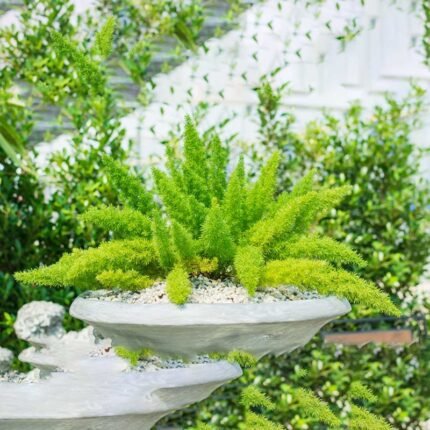BUCIDA
Bucida buceras, Though commonly called ‘black olive tree’, this native of the upper Florida Keys is not the edible olive we know and love but does produce a small, black seed capsule. Black olive is a 40 to 50-foot-tall evergreen tree with a smooth trunk holding up strong, wind-resistant branches, forming a pyramidal shape when young but developing a very dense, full, oval to rounded crown with age. Sometimes the top of the crown will flatten with age, and the tree grows horizontally. The lush, dark bluish-green, leathery leaves are two to four inches long and clustered at branch tips, sometimes mixed with the 0.5 to 1.5-inch-long spines found along the branches.
BOGAINVILLEA
Botanically, the plants are classified as woody vines, although they often behave more like shrubs. In fact, they can easily be trained to grow as shrubs . The foliage of these tropical flowers is usually evergreen in warm climates, but their leaves will sometimes drop if watering has been insufficient. These vines can attain a height and spread of 15-40 feet and contain thorns. What appears to be the flower on bougainvillea plants is actually a foliar structure referred to as a “bract.” The flower, technically, is much smaller and not nearly as eye-catching.
BISMARCK PALM
The Bismarck Palm, scientifically known as Bismarckia Nobilis, is a stunning and majestic palm tree that is native to Madagascar. It is a slow-growing palm that can reach a height of 30 feet and a width of 20 feet, making it a perfect choice for large landscapes and gardens. The Bismarck Palm has a single, thick trunk that is covered in a grayish-brown bark, and it is topped with a crown of large, fan-shaped leaves that can grow up to 10 feet in diameter. The leaves are a beautiful silvery-blue color, which makes them stand out in any landscape. The Bismarck Palm is a hardy plant that can tolerate a wide range of soil types and temperatures, making it an ideal choice for tropical and subtropical regions. It requires full sun exposure to thrive and should be watered regularly during the growing season. The Bismarck Palm is also resistant to most pests and diseases.
BASIL PLANT
Basil plants are one of the most popular herbs to grow and also one of the easiest. Sweet basil (Ocimum basilicum) is a member of the mint family. It is closely identified with Italian cooking, although it is originally from India. The extremely aromatic leaves also have a delightful variety of flavors, from the slightly lemony-mint of sweet basil to cinnamon and licorice. Leaf colors span from rich green to deep purple, with smooth or crinkled leaves. The flowers are insignificant but very popular with bees.
BARREL CACTUS
The aptly named golden barrel cactus or golden ball (Echinocactus grusonii) rarely grows in its native habitat. It is sometimes used in the outdoor garden in dry climates where temperatures never fall below 4 degrees Celsius. It’s called a barrel cactus because, as the name implies, they are almost perfectly round when juvenile. They are beautiful, with evenly spaced rows of spines on their deeply ribbed lobes. As they grow, it’s not uncommon for them to stretch out, so they are more oval than circular.
ASPARAGUS SPRENGERI
Normally planted in the spring, the fast-growing asparagus fern has a lot of good qualities, but it comes with some important cautions. In warm, humid climates, asparagus ferns can spread rapidly when planted outdoors—to the point of serious invasiveness. Neither plant is a fern, but instead, they are warm-weather perennials closely related to the common edible garden asparagus.
AGAVE
Agave plants are succulents with large leaves that end in pointy tips. Large, stiff specimens can grow to 10 feet or more in height and width, and smaller species can be dish-sized. A few agave species have soft leaves and no spines. Agave grows best in rocky, sandy, well-drained soil in full sun. Fertilizer can encourage agave to bloom, which is not recommended because the plant only blooms once, then dies.
ARECA
Areca palm plant is widely known for its long, graceful feather-shaped fronds, and clustered stems with yellow-green leaflets. They are one of the most widely used indoor gardening plants relevant mostly for bright interiors. Areca Palm plant will add a tropical feel to your indoor spaces and is especially well suited for screened patios and atrium. Keeping the Areca palm plant as an indoor plant could result in good air quality in your surroundings. This is because they are best at absorbing formaldehyde coming out of electronics or laptops and it also cleans up other harmful toxins. Thus, making an excellent environment for your indoor spaces.
ARAUCARIA
Araucaria is suitable for growing indoors as a houseplant. It has a graceful pyramidal shape with graceful, wide-spaced branches symmetrically arranged in whorled, horizontal tiers around a single straight trunk. There are typically five branches per whorl. In its native habitat, it reaches heights of 200 feet. Cultivated trees, grown in subtropical or Mediterranean climates typically grow to 60-100 feet with a 12-60 foot spread. It grows best in open, full sun locations with ample room for its large size, in any well-drained soil type. Outdoors, surface roots may interfere with lawn mowing or lift sidewalks and large cones create litter.
ANTHURIUM
Anthurium is a perennial plant native to Central America, northern South America, and the Caribbean. While they can be grown outdoors in the garden in warm climates, anthuriums are good indoor plants and are more often grown as houseplants or in greenhouses since they have particular care needs. They grow at a slow or moderate growth rate, depending on getting ample light without getting sunburned. Also called flamingo flowers for their unique tropical shape and bright red, green, and white colors, they can constantly bloom for long periods making them delightful indoor plants year-round. The blooming varieties are distinctive for their colorful, heart-shaped waxy spathes and red or yellow tail-like flower spikes. Other varieties feature large-leaved, deeply veined foliage. Many anthuriums are climbers, and all need high humidity and warmth to thrive. Anthurium typically lives about 5 years indoors with proper care but by propagating your plant, you can have a healthy anthurium indefinitely.
ALOCASIA
Boasting some of the most striking foliage in the houseplant world, the Alocasia is an increasingly popular addition to indoor plant collections due to its unmatched visual and sculptural appeal. There are around 80 species of this distinctly veined stunner native to subtropical Asia and eastern Australia, and some specimens boast leaves that can grow up to almost three feet long.
Alocasias need bright, but indirect light. This is due to the plant’s natural habitat, on the forest floor beneath the tree canopy. Direct sun will cause the leaves to burn, so avoid placing your Alocasia in a spot where it’ll be exposed to direct sun for a prolonged period. This plant is not tolerant of lower light conditions though, so make sure the space you’re placing yours in feels very bright. Alocasias are native to — and grow best — in humid environments, so avoid placing yours near to an A/C or a heater if possible.
AGLAONEMA SILVER QUEEN
The marbled darker green color allows this Chinese Evergreen to tolerate some degree of shade. The leaves tend to grow in an upright manner. Chinese Evergreens are on NASA’s list of air-purifying plants. They are proven to remove Benzene and Formaldehyde toxins present in home environments and help reduce the irritant side-effects to humans. Aglaonema Silver Queen is a popular variety, often found in design schemes, either used as a feature plant or displayed with a complimentary mix of other Chinese Evergreens. It is primarily grown for its attractive variegated foliage and not for its insignificant flowers. Thick, elliptic to lance-shaped, dark green leaves with attractive silver-gray variegation appear on short stems rising from the soil. Leaves are silvery-white with green margins and veins. As the plant ages, it begins to develop a trunk-like stem as the lower leaves fall off. Flowers appear on a small creamy white spadix surrounded by a greenish-yellow spathe. Flowers usually bloom in summe


























